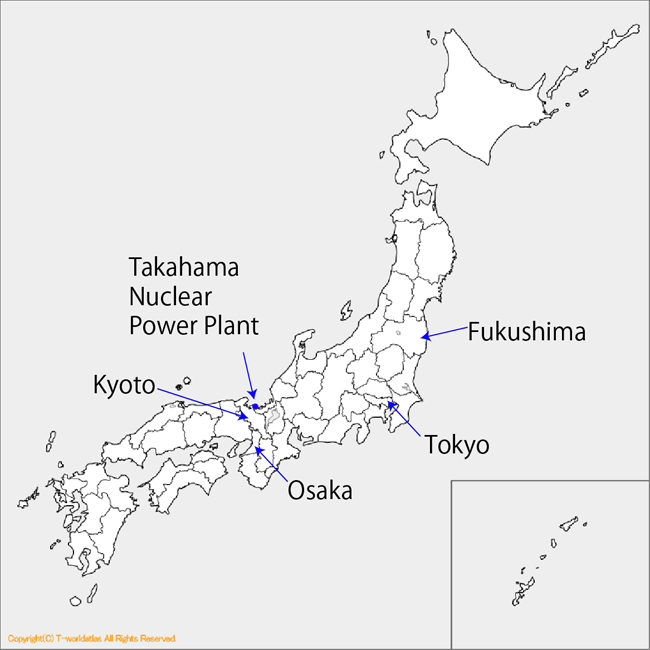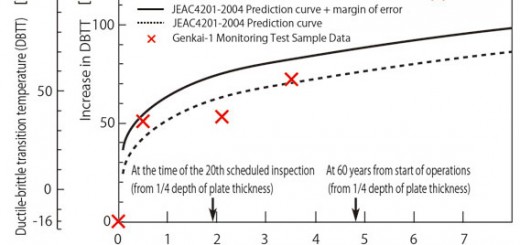CNIC Public Comment on the Draft Report for the New Regulatory Requirements Screening for the Kansai Electric Power Company’s Takahama Nuclear Power Plant Nuke Info Tokyo No. 164
 |
| Location of the Takahama Nuclear Power Plant |
Background
As a result of reflection on the Tokyo Electric Power Company Fukushima Daiichi Nuclear Power Station (FDNPS) accident, the regulation of the use of nuclear power has been placed under the jurisdiction of the Nuclear Regulation Authority (NRA), inaugurated in September 2012. The amended Nuclear Regulation Law, mandating countermeasures against severe accidents (incidents far exceeding presumed possible accidents, in which serious damage occurs to a reactor core, etc.), and the regulatory requirements that give concrete expression to the law, entered into force in July 2013. Since compliance with the new regulatory requirements is required for nuclear power plants already in operation, each of the power companies is applying to the NRA to screen for compliance with the new regulatory requirements as soon as preparations for the application are complete. (As of January 2015, 19 nuclear reactors operated by 11 power companies are undergoing screening.)
The draft report for the new regulatory requirements compliance screening for the Kansai Electric Power Company’s (KEPCO) Takahama Nuclear Power Plant Units 3 and 4 was released in December 2014. This is the second draft report to be released, following the draft report for new regulatory requirements compliance screening for the Kyushu Electric Power Company’s Sendai Nuclear Power Plant Units 1 and 2, which was published in July 2014 and approved by the NRA in September (NIT 162).
A call for public comments regarding KEPCO’s draft report was issued for the period December 18, 2014 to January 16, 2015, to which CNIC responded by submitting an opinion.
Issue 1: Problems of the new regulatory requirements themselves
The new regulatory requirements have been formulated based on the lessons learned from the FDNPS accident, and it is a fact that some improvements compared with the former requirements have been seen in the items incorporated as countermeasures against severe accidents, etc. However, these requirements have been formulated before the causes of the FDNPS accident have been thoroughly clarified, and from that point of view the requirements entail immense problems.
For instance, the NRA still maintains that the cause of the FDNPS accident was the tsunami and not the earthquake, but as pointed out by Mitsuhiko Tanaka, member of the now-disbanded National Diet of Japan Fukushima Nuclear Accident Independent Investigation Commission (NAIIC), a large number of phenomena that cannot be explained by the tsunami alone occurred during the FDNPS accident. If, in fact, a part of the important functions of the NPS were damaged by the earthquake, then it would be necessary to carry out a fundamental review of the seismic screening guidelines currently in force. However, there is no evidence to show that any such review was part of the formulation process of the new regulatory requirements.
Further, a part of the facilities for countermeasures against severe accidents, such as the intentional crash of a large aircraft into an NPP, have been given a five-year grace period, and we also believe this to be a grave problem.
Issue 2: The problem of MOX fuel
KEPCO has applied for the new regulatory requirements compliance screening on the premise that the Takahama NPP Units 3 and 4 will be loaded with MOX fuel. The draft report states that the critical boron concentration* will be set at 1,850 ppm, somewhat higher than the roughly 1,700 ppm for general uranium reactor cores. This is because MOX fuel is more reactive than uranium fuel.
According to the severe accident scenarios in the application document to NRA from KEPCO, the boron concentration in the primary coolant is usually set at 2,800 ppm at Takahama NPP. If, due to some accident, an inflow of pure water causes a reduction in the boron concentration, a mere one minute is all the time that will be available to stop the concentration reduction before it reaches the critical boron concentration. When some kind of trouble arises, will it be possible to deal with the situation with only this thin margin of safety?
Furthermore, it has been claimed that all spent fuel will be reprocessed in Japan, but even the Rokkasho reprocessing plant, intended for the reprocessing of spent uranium fuel, has had to postpone the start of operations 22 times and is effectively inoperable. There is no likelihood of a MOX fuel reprocessing plant being constructed in this situation. Thus the MOX fuel used at Takahama NPP has nowhere to go and will simply continue to accumulate at the NPP site. Since spent MOX fuel has a higher heat release value than spent uranium fuel, it will be necessary to store it in a spent fuel pool for a longer period.
NRA maintains that the behavior and characteristics of MOX fuel differ very little from uranium fuel, and that therefore no special safety standards are necessary. However, the nuclear reactions are extremely fast, difficult to control, and can very rapidly get out of hand once the means of control have been overwhelmed by the reactions. The reaction is accelerated and difficult to control in the case of MOX fuel. Moreover, the storage of MOX fuel at NPP sites is a huge cause for concern and anxiety among local residents. It is unacceptable that MOX fuel should be used without special safety standards.
Issue 3: The arbitrary use of analysis codes and the whittling away of accident likelihoods
KEPCO claims that the analysis codes it uses in countermeasure scenarios against severe accidents are appropriate, and the NRA has approved this procedure.
For instance, in the scenarios submitted by KEPCO, up until the time when the reactor vessel is damaged, 75% of all the zirconium in the reactor core reacts with water. The hydrogen then produced by the molten core concrete interaction (MCCI) is said, according to the analysis code MAAP (an analysis code which gives the extremely safe result that once the MCCI reaction begins all other reactions will cease), to be 6% of the amount of the zirconium, resulting in the hydrogen concentration being at or lower than 13% by volume. This 13% by volume is the judgement criterion for a detonation stipulated in the regulatory requirements. In other words, use of the result of the MAAP analysis will lead to highly dangerous design conditions.
However, despite the fact that the NRA acting chairman Fuketa has recognized that the analysis code for MCCI has not yet reached the level of practical application (September 24, 2014 regular press conference), the NRA has approved this analysis result and claims that assuming 75% of the zirconium reacts is, in itself, sufficiently conservative and that there is therefore no problem.
What this means is that KEPCO has carried out an arbitrary analysis in order to clear the numerical hurdles required by the regulatory requirements, and by saying that the regulatory requirements have been set conservatively, the NRA has then approved the analysis. There are far too many of these arbitrary usages of analysis codes to mention, and this procedure of using codes to whittle away the likelihood of the occurrence of accidents is an extremely serious problem.
NAIIC report here warp.da.ndl.go.jp/info:ndljp/pid/3856371/naiic.go.jp/en/report/
*In pressurized water reactors, the output of the reactor is adjusted by the absorption of neutrons by boron dissolved in the primary coolant. The concentration of boron at criticality is known as the critical boron concentration.
(Hajime Matsukubo, CNIC)

